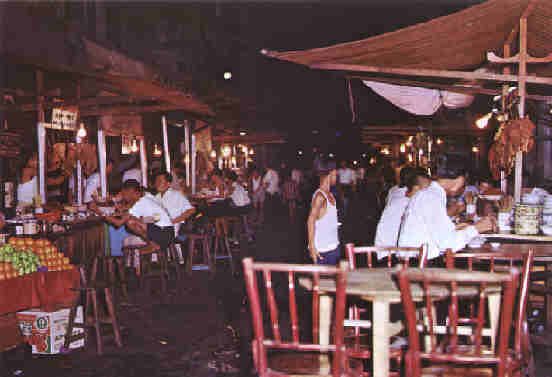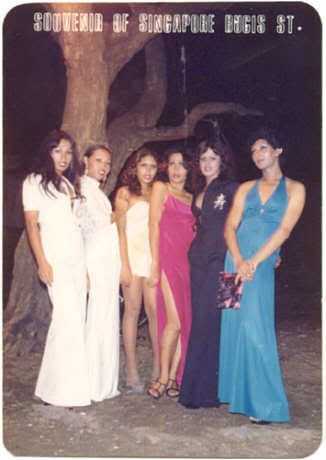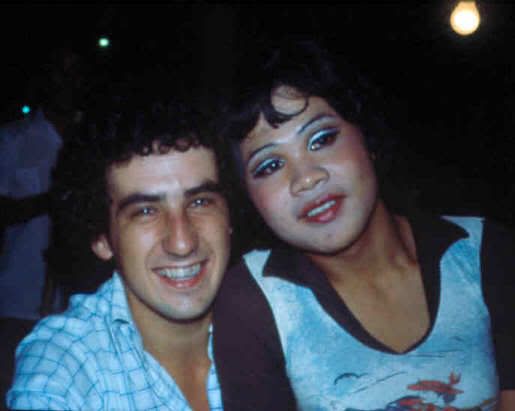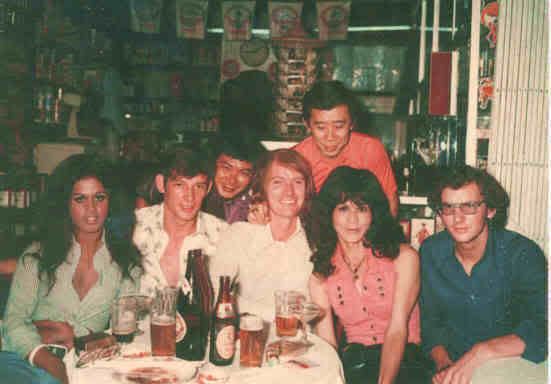
In a book by Don Kulick, a picture of a wall scrolled with the Brazilian words, "Issao nao e Verdade," is found in its very first pages. The wall is actually located along a steep narrow alley with enormous potholes in Sao Francisco Street in Salvador, Brazil. The words mean, "this is not real" in its English translation. Kulick thinks this is a reminder to anyone who is passing through this place that one is entering a different realm, a place where appearances might be deceiving and where what was real and what was not was very much a question of one's desires, point of view and frame of mind...
But hundreds of miles away, in an era long gone, a most unique place in sunny Singapore once existed which would have given so much justice to the phrase in that wall. Bugis Street in the 1950s to the 1980s was all food stalls, wet market and affordable restaurants in the light of day but when the darkness of night took over a most magical phenomenon took place. A parade of beautiful women dressed in the most flamboyant and provocative ensembles lit the place literally. They would sashay down the street, oblivious to the screaming and cajoling of the Western tourists and the locals but very very mindful of the potential amorous gaze of the moneyed Caucasian. There was only one twist to this event. The individuals who lent their presence to this Vaudeville were not real females. They were transsexuals and transvestites - boys who dared to cross the gender lines from their original masculine origin to the other side of the chasm.
Despite this transgression of gender norms, the "fashion" event and the "girls" were well-received by the Western boys and even caused such a stir in the international scene because of the simple fact that they were more beauteous than real women. There was an adage amongst Westerners that one could easily tell who was a real female and who was not - the transwomen were drop-dead gorgeous, while the rest were real women.
More importantly a most profitable trade flourished in this area. The transgirls would solicit "financial donations" from the half-drunk sailors, American GIs and other foreigners on rest and recreation in exchange for the thrill of intimacy with not only an exotic oriental but also the added spice of destroying gender boundaries in a steamy session. The income that the girls took in from their dealings gave the Singapore tourism industry a major boost.
But hundreds of miles away, in an era long gone, a most unique place in sunny Singapore once existed which would have given so much justice to the phrase in that wall. Bugis Street in the 1950s to the 1980s was all food stalls, wet market and affordable restaurants in the light of day but when the darkness of night took over a most magical phenomenon took place. A parade of beautiful women dressed in the most flamboyant and provocative ensembles lit the place literally. They would sashay down the street, oblivious to the screaming and cajoling of the Western tourists and the locals but very very mindful of the potential amorous gaze of the moneyed Caucasian. There was only one twist to this event. The individuals who lent their presence to this Vaudeville were not real females. They were transsexuals and transvestites - boys who dared to cross the gender lines from their original masculine origin to the other side of the chasm.
Despite this transgression of gender norms, the "fashion" event and the "girls" were well-received by the Western boys and even caused such a stir in the international scene because of the simple fact that they were more beauteous than real women. There was an adage amongst Westerners that one could easily tell who was a real female and who was not - the transwomen were drop-dead gorgeous, while the rest were real women.
More importantly a most profitable trade flourished in this area. The transgirls would solicit "financial donations" from the half-drunk sailors, American GIs and other foreigners on rest and recreation in exchange for the thrill of intimacy with not only an exotic oriental but also the added spice of destroying gender boundaries in a steamy session. The income that the girls took in from their dealings gave the Singapore tourism industry a major boost.
Not surprisingly the transgirls were not the only ones to put on a show in the area. There was a public lavatory which had a flat roof in the vicinity and without too much effort and in spite of being drunk many an Aussie, American or English lad or local ladyboy would climb up and put on an impromptu show. One such incident was when a U.S. sailor stripped and got up on the roof. He then rolled up a newspaper, stuck it in his ass and lit the newspaper whilst his mates took pictures! This event spurred on the "Dance of the Flaming Arseholes" tradition performed by drunk sailors. Supportive compatriots would clap and sing tunes while the actor performed on his make-believe stage.
Because booze was involved and alcohol clouds the mind, fights were not uncommon between conflicting parties. Usually it was between rival ships from the US Navy or US Navy versus the Royal Navy or sometimes with the involvement of the Australian Navy. Bottles would start flying all over the place and punches would be exchanged. The military police would get wind of this and they would soon turn up and make arrests.
These events all coalesce into the colorful and beautiful collage called Bugis Street. But the Singapore government took on a different perspective. The authorities eventually caught up to the legal trespassings of the delinquent sailors and the blatant flesh trade. Arrests were made and some of the Westerners were even dealt with severely and sent home. Singapore started to revamp the whole area in an effort to "clean up" their act but they earned the subtle criticism of the tourist and local population for doing so. Lamentation over the loss of this cultural staple pushed Singapore tourism chiefs to attempt to recreate some of the splendour of the old Bugis Street by staging articially contrived stage performances which never really matched up to the magnanimity of the real show put on years earlier by the gorgeous transwomen. The idea fizzled inevitably of course.
The spectacle that is Bugis will forever be etched in Singapore's history and for me, more significantly too, in the memories of men who have dared to cross the gender lines and sexual convention. Not only did this seemingly uneventful experience for the people who were really there to experience it all become such a cultural marvel years later, it also turned into a symbol of sexual revolution for people who assume that there are no other permutations in the basic human sexual act. The premise that man is meant for woman and woman is meant for man is a dilapidated and old-fashioned combination and should give precedence to other erotic equations. There are many ways to enjoy the sensual experience more than the so-called norms and the spectacle that is Bugis Street certainly mocked many sex bibles with all that transpired in this colorful area AND era of Singapore's historical strata and the world's sex diary.



NOTE: This spectacular article would never be possible without the help of DickRick who is my guardian/confidante in Singapore and Wikipedia and my lamentable head for putting the whole piece together despite being weary from booze LOL....Thank you so much....

2 comments:
Well done Liisa, you've turned my bits and pieces to a marvellous narration.
Liisa,
Thanks for a magnificent and thought provoking article. It takes me back to the 1970’s when I was a young, half drunk (well sometimes I was only half drunk) sailor running WILD in Honolulu, Subic, Manila, Hong Kong, and yes Singapore. It seemed like we could get away with anything in those days. Today’s sailor would definitely get in serious trouble for doing the things that we did back then. I think maybe we had more freedom back then…for example, like the sailor in your article, I would think nothing of dropping my trousers on the floor and dancing on top of a table, or jumping off a diving board at a large international hotel in Manila, naked.
Regrettably, I never made it to Bugis Street when I went to Singapore in 1976, although I had heard of the spectacle of the fashion show from another sailor who had been there on a previous trip. I’m not sure if I didn’t know how to get there, or maybe I just settled for the small strip of bars located just outside of the Aussie (I think it was Aussie) Navy base (and close to my ship). These bars also featured beautiful transsexual go go girls…but the girls were greatly outnumbered by the sailors and I had to settle for getting drunk and eating fish and chips. Your description of the fights is accurate as well (although I was mostly able to avoid fighting). The pictures you included remind me of every picture I ever saw that was taken at any bar in Olongapo City during the 1970’s.
Thanks for helping me to resurrect my memories of a wonderful and exciting time in my life. I feel like you wrote this article just for me. You are a gifted writer.
Thanks,
John
Post a Comment